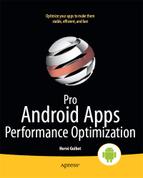Book Description
Today's Android apps developers are often running into the need to refine, improve and optimize their apps performances. As more complex apps can be created, it is even more important for developers to deal with this critical issue.
Android allows developers to write apps using Java, C or a combination of both with the Android SDK and the Android NDK. Pro Android Apps Performance Optimization reveals how to fine-tune your Android apps, making them more stable and faster. In this book, you'll learn the following:
How to optimize your Java code with the SDK, but also how to write and optimize native code using advanced features of the Android NDK such as using ARM single instruction multiple data (SIMD) instructions (in C or assembly)
How to use multithreading in your application, how make best use of memory and how to maximize battery life
How to use to some OpenGL optimizations and to Renderscript, a new feature in Android 3.0 (Honeycomb) and expanded in Android 4.0 (Ice Cream Sandwich).
After reading and using this book, you'll be a better coder and your apps will be better-coded. Better-performing apps mean better reviews and eventually, more money for you as the app developer or your indie shop.
What you'll learn
How to optimize your applications in Java
How to optimize your applications using the NDK
How to best use memory to maximize performance
How to maximize battery life
How and when to use multi-threading
How to benchmark and profile your code
How to optimize OpenGL code and use Renderscript
Who this book is for
Android developers already familiar with Java and Android SDK, who want to go one step further and learn how to maximize performance.
Table of Contents
- Title
- Contents at a Glance
- Contents
- About the Author
- About the Technical Reviewers
- Acknowledgments
- Introduction
- Chapter 1: Optimizing Java Code
- Chapter 2: Getting Started With the NDK
- Chapter 3: Advanced NDK
- Chapter 4: Using Memory Efficiently
- Chapter 5: Multithreading and Synchronization
- Chapter 6: Benchmarking And Profiling
- Chapter 7: Maximizing Battery Life
- Chapter 8: Graphics
- Chapter 9: RenderScript
- Index
